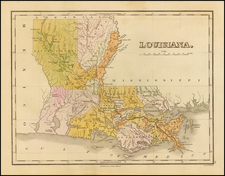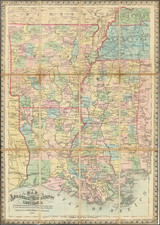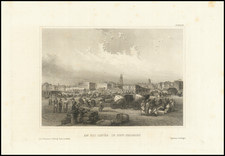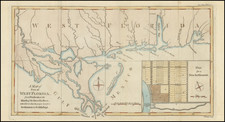A Remarkable Early Map of The Modernizing City of New Orleans
Remarkable early map of New Orleans, issued in the year following several of its most important modernizations, published by recent arrival Henry Moellhausen in 1837.
Moellhausen's map is almost certainly the earliest printed map to depict two important milestones in New Orleans history, the successful completion of the new public water-works by the Commercial Bank of New Orleans in April 1836 and the creation of the Three Municipalities in March 1836. The map is also quite remarkable for its location of every individual fire-plug in the city.
Moellhausen's map is issued at a fascinating moment in New Orleans history, a decade that saw the population of the city double with the swell of German, French, and other immigrants, to become the wealthiest and third-most populous city in the nation.
The map shows New Orleans oriented with northwest at the top of the map. Only the area on the Northwest side of the Mississippi River is shown, with only a single ferry crossing to the opposite side of the River. The city is divided into 3 colored sections, reflecting the creation of the Three Municipalities in 1836, a division created to address the concerns of the Anglo and French-Creole communities. On March 8, 1836, the state legislature amended New Orleans' original 1805 charter by dividing the city "into three separate sections, each with distinct municipal powers." The First Municipality would include the French Quarter and Faubourg Treme; the Second Municipality would run from Canal Street to the upper city limit of Felicity Street, and the Third Municipality spanned from Esplanade Avenue down to the present-day St. Bernard Parish line. The three municipalities were then sectioned into wards, each of which elected a number of aldermen based on their population size.
Another fascinating component of the map is its list of Foreign Consuls, a recognition of the international trading importance of New Orleans. Foreign Consuls listed include a number of European powers, as well as consul for the Republic of Texas (Nathaniel Townsend), Columbia, Brazil, and Mexico, and several Hanseatic cities.
The map also shows the rail lines operating within the city of New Orleans. The Pontchartrain Railroad (named on the map) had begun operations in 1831, with the New Orleans and Carrollton Railroad (unnamed, but shown on the map) opening in 1835. The Depot House and line of the Nashville Railroad are also shown on the map.
As noted in the title, the map locates:
- Water Pipes
- Fire Plugs
- Railroads
- Municipalities (3, colored coded)
The map notes that it was:
- Executed at the Lithographic Institution of E. Johns & Co. corner of St. Charles & Common Sts. opposite the Exchange Hotel
- Engraved on Stone by Julius Manouvrier Lithographer
- Printed by H. Lauve
Historical Context / Mapping New Orleans
While Mollhausen's map of New Orleans is not among the earliest maps of New Orleans, it is unquestionably a map of great historical import. Unlike the great maps of New Orleans issued in the preceding decade, including the maps by Francis Ogden (1829) and Charles Zimpel (1835), the present map shows public works, political boundaries, and transit information that did not yet exist at the time of the publication of these earlier maps. Moreover, Moellhausen's addition of every fireplug in the city is an extraordinary compilation in its own right.
This was unquestionably Moellhausen's effort to introduce himself as a new professional arrival to New Orleans, with a large advertisement announcing his services coming the following October in the New Orleans Times-Picayune.
New Orleans History / Early Water-Works & Fire Plugs
The earliest public water projects in New Orleans dates to the first decade of the 19th Century. In 1806, Mayor John Watkins saw the need for a public water supply and wrote Julian Poydras, the Territory's representative in Congress, asking him to engage Benjamin Latrobe to create a system similar to the one Latrobe had built in Philadelphia. President Thomas Jefferson also raised the subject with Latrobe in August 1807. While Latrobe was investigating his options, the City of New Orleans granted a water franchise to Louis Gleise in May 1810. Gleise is said by several historians as having built a system, but when he had not completed sufficient work within a year, the city awarded an exclusive franchise to Benjamin Latrobe in May 1811.
Latrobe sent his son Henry to secure his franchise, who was successful in securing a franchise in April, 1811, which anticipated a steam-powered pumping station sited on a vacant lot adjacent to Latrobe's Custom House, defined by Bienville, Custom House, and Levee streets and the high road. When the first location was not available, Henry returned to New Orleans in February, 1812 and secured a lot bounded by Ursuline, St. Phillips, and Levee streets. He received bids for construction of the building on March 20, 1812 The building would house a steam engine to pump water from the Mississippi river into six elevated wooden casks. He and his father spent several years and made some progress, but Henry died of yellow fever in 1817, after which Latrobe went to New Orleans, where he also died of yellow fever on September 3, 1820.
The system was bought by the city on May 26, 1821, and local engineers Francis B. Ogden and William W. Montgomery, a council member and local merchant, were sent to Philadelphia to buy pipe and other materials to finish the works. The system began working sometime in 1823, but never proved satisfactory. The pumphouse was abandoned and demolished in 1838 after new waterworks came online.
The Commercial Bank of New Orleans was incorporated by the legislature on April 1, 1833, and given a thirty-five-year exclusive right to supply water to the city of New Orleans. The company hired Albert Stein to design and build the works, which began operation on April 28, 1836, by pumping water into a reservoir constructed on a built-up mound.
Rarity
The map is apparently a unique survival. We are unable to locate any other examples.
Provenance: Bolaffi, 2020.













![[ Map of the Mississippi River ]](https://storage.googleapis.com/raremaps/img/small/99811.jpg)


![[ New Orleans ] Grondvlakte van Nieuw Orleans, de Hoofdstad van Louisiana [with] De Uitloop vande Rivier Missisippi [and] De Oostelyke ingang van de Missisippi met cen Plan van het Fort . . .](https://storage.googleapis.com/raremaps/img/small/93086.jpg)